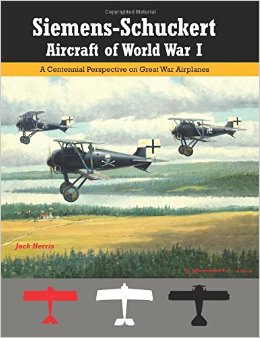
Siemens-Schuckert Aircraft of World War I
By Matt Bittner
Author: Jack Herris
Publisher: Aeronaut Books
ISBN #: 978-1-935881-23-0
Binding: Softcover
Pages: 208
Within this book there are naturally chapters on their single-seaters, as the SSW (Siemens-Schuckert Werke) D.III and D.IV are the best known, and when they were produced, the best fighters during the war. But in addition to those two the book covers the earlier single-seaters, which if you didn't know were actually better than the Fokker and Pfalz E-types but arrived too late to make a difference. When they arrived aircraft manufacturers were already on to biplanes that had better handling than the early monoplanes. All of the SSW E-types were relegated to training duties. In addition, this book is the best reference on the SSW D.I, a Nieuport 11/16-clone but utilized the Siemens-Halske S.I engine.
However, the book covers all SSW aircraft, not just the better-known single-seat fighters. For example, the only other manufacturer of Reisenflugzeuge (giant aircraft, also called an R-plane) was Siemens-Schuckert (Zeppelin-Staaken being the other manufacturer). The last was the R.VIII, a mammoth aircraft utilizing six coupled engines turning four huge propellers. While one was completed (and Siemens-Schuckert had to build a new hangar just for that aircraft) it never flew due to problems with engine delivery and problems with the drive system, none of it figured out before the Armistice. At the time - and for ten years afterwards - it was the largest aircraft in the world.
SSW was also the only WWI company to experiment with "guided missiles", or as described in the book, guided glide-bombs. The company created what were basically large gliders with a warhead (or a torpedo) attached and using five miles worth of cable, could be controlled from the launching platform (during trials a Zeppelin).
Finally the last major section in the book deals with the Siemens-Halske engines which were really highly developed engines for their time.
Not only are their period photographs, tables outlining the delivery of every airframe and excellent color profiles by Bob Pearson, but there is also a section containing contemporary photographs. An SSW D.IV was modified post-war to become a high-altitude fighter by Albatros and labeled the H.I. The fuselage of this aircraft still exists and in the past few years went through restoration and is displayed at Krakow, Poland. These are color photos and include a lot of detail shots so if you want to model the H.I you have an excellent resource contained within this book.
Buy this book, especially if you're a fan of WW1 aviation and/or Siemens-Schuckert aircraft. I feel it is a must for not only the historian but also modeler.
Many, many thanks to Aeronaut Books for sending this for review. Contact them direct for ordering information.
